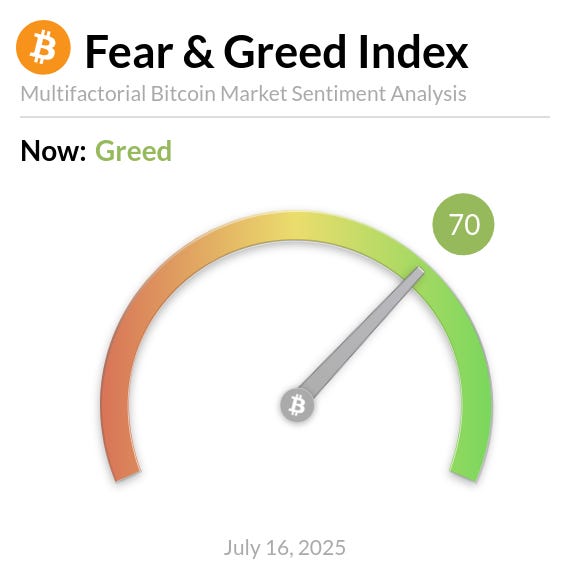Bitcoin Daily Commentary –16 July 2025
Bitcoin dips 1.2% post-CPI print as inflation heats up again, but retail and ETF demand still outpace new supply, suggesting the pullback may be a pause, not a peak.
Bitcoin's price is down 1.2% over the past 24 hours, trading at $118,100 following the release of the June US Consumer Price Index (CPI), which showed inflation rising for the second straight month. Headline CPI hit 2.7% year-over-year, the highest since February, matching expectations but up from 2.4% in May. Core CPI also ticked higher to 2.9% annually, though it came in slightly below forecasts (3%). Overall CPI rose 0.3% month-over-month, the sharpest gain in five months, with core inflation up 0.2%. The data underscores that inflation remains sticky, especially in key segments like food and transportation, while shelter prices have only marginally eased. US equity markets reacted cautiously, while the US Dollar Index (DXY) sharply rose to 98.5, up 2.1% in July.
Bitcoin's dominance is lower over the past 24 hours, falling to 62.9% from 63.6% yesterday.
Sentiment is weaker over the past 24 hours with the Bitcoin Fear & Greed Index falling to 70 but still in Greed territory.
Bitcoin pulled back after hitting a new all-time high of $123,218 on Monday, indicating profit-booking at higher levels. The correction seems to be technical in nature, as the underlying demand remains strong.
Retail investors were not to be left behind. Bitfinex analysts said in a report that demand from Shrimp (<1 BTC), Crab (1–10 BTC), and Fish (10–100 BTC) Bitcoin holder groups is at 19,300 BTC per month, which is more than the new monthly supply of about 13,400 BTC since the April 2024 halving.
Bitcoin has surged to a new ATH, breaking out of its prolonged consolidation between $100,000 and $110,000 to reach $123,120, marking a 12.2% move beyond January’s peak and a 65% rally from the April lows. This move was powered by short-term holders aggressively bidding. Bitcoin’s sharp rebound from the tariff-induced April panic has firmly reasserted its status as a macro-resilient asset, outperforming traditional hedges like gold and equities. In a market grappling with global uncertainty, Bitcoin’s unique positioning as a high-beta safe haven is increasingly validated.
Now the fifth-largest asset in the world with a $2.43 trillion market cap, Bitcoin has surpassed both silver and Amazon, in terms of market valuation. ETF-driven demand continues to dominate, with US spot Bitcoin ETFs recording over $2.7 billion in inflows last week, significantly outpacing the mined supply of BTC last week, with BlackRock’s IBIT ETF reaching $80 billion in AUM faster than any ETF in history. Meanwhile, grassroots accumulation by wallet cohorts under 100 BTC is also outpacing new issuance by a wide margin, reducing further supply pressure.
Bitcoin’s role as a digitally native monetary asset, validated by sovereign-grade allocators and balance sheet investors, is driving its ascent through the global asset rankings. The price action reflects more than just momentum; it represents a fundamental repricing of Bitcoin’s role in institutional portfolios and macro frameworks. And while headline economic indicators also suggest broader stability in the US, a closer examination reveals deepening cracks beneath the surface. Labour market dynamics are weakening, with rising continuing jobless claims pointing to challenges in workforce reintegration, especially in entry-level roles.
Simultaneously, consumer sentiment is cautiously optimistic but weighed down by persistent structural strains; elevated credit costs, essential living expenses, and growing geopolitical uncertainty are testing household resilience. On Main Street, small businesses are feeling the pinch. Despite stable readings in business surveys, data shows that many companies are grappling with sluggish sales, rising input costs, and hiring mismatches, forcing them to scale back investments and hiring plans. Meanwhile, Wall Street is showing its own signs of fragility, with a depreciating dollar, rising Treasury yields, and widening credit spreads reflecting heightened investor anxiety and scepticism toward US fiscal and monetary policy.
Holding Bitcoin Isn’t Enough.
Volatility, uncertainty, and regulatory risk make it harder than ever to build wealth simply by holding Bitcoin. Even ETFs cap your upside and don’t generate income.
Some funds try to fix this with complex strategies, but they often sacrifice growth, limit compounding, or only work in bull markets. Worse, they pay out in fiat, not Bitcoin.
The Radiance Multi-Strategy Fund solves all of that.
It’s a professionally managed, income-generating Bitcoin fund that compounds with high frequency, delivers uncapped upside, and pays income directly in BTC. If you're serious about long-term Bitcoin growth, download the fact sheet now.
In corporate news:
· Strategy resumed its weekly BTC purchasing operations after a pause at the end of Q2. Strategy added 4,225 BTC to its treasury, buying just ahead of a new series of BTC records. The average purchase price was at $111,127, raising the average acquisition price to $71,268. In total, Strategy now holds 601,550 BTC and the BTC buying round was financed with sales of all types of Strategy stock, a mix of common and preferred shares. The bulk of funding came from placing MSTR shares for $330.9M. With the added sales of STRF, STRK, and STRD, Strategy had $472.3M for the current BTC operation.
· A Cantor Fitzgerald-backed vehicle, Cantor Equity Partners, is in late-stage talks with Adam Back to buy between $3 billion and $4 billion worth of BTC, according to a Financial Times report, citing two anonymous sources. Cantor Equity Partners is a special purpose acquisition company (SPAC) that closed on $200 million from an initial public offering in January.








